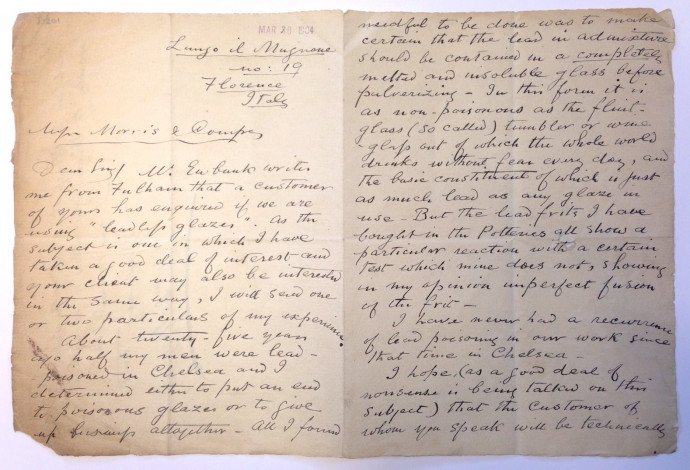This letter is a response from the ceramicist William De Morgan to an enquiry from Morris and Co. about the use of leadless glazes in his pottery. In the letter, (which he wrote from Florence, Italy) de Morgan describes how ‘twenty five years ago half my men were lead-poisoned in Chelsea and I determined either to put an end to poisonous glazes or to give up business all together‘.
De Morgan expresses some frustration in his letter to ‘the nonsense…being talked on the matter‘ of lead glazes. By the early twentieth century the issue of lead poisoning had become a significant matter of public concern. A wide body of scientific and medical information was produced concerning the danger to factory workers who came into contact with lead, as well as the use of lead paint in homes. This was picked up in the popular press and the health risks associated with lead became more widely known among ordinary people.
Lead glazes allow for a very shiny and transparent finish, which De Morgan’s ceramics were famed for. His relationship with Morris & Co. started in the 1860s when William Morris commissioned his friend to decorate tiles for his decorating firm. Later, Morris & Co. sold a large range of De Morgan’s ceramics which had become highly fashionable.
De Morgan was extremely knowledgeable on the subject of ceramic glazes- studying historic techniques used in the Middle East and Italy and experimenting in his workshop to produce high quality ceramics. In the letter he goes on to explain how he did not give up the use of lead- ‘all I found needful to be done was to make certain that the lead in our(?) mixture should be contained in a completely melted and insoluble glass before pulverizing- In this form it is as non-poisonous as the flint-glass (so called) tumbler or wine-glass out of which the whole world drinks without fear everyday‘. By melting the lead compounds with other materials such as silica to form a glass ‘frit’ or ‘flux’, lead glazes were much safer to use than the previous raw lead compounds since they were less soluble in stomach acids.

